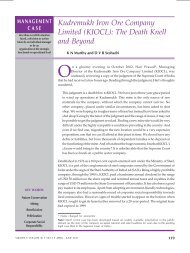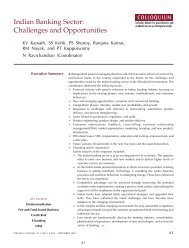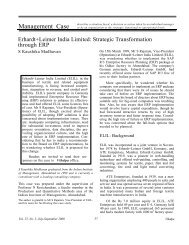Executive Summary A Study on Return on Investment of ... - Vikalpa
Executive Summary A Study on Return on Investment of ... - Vikalpa
Executive Summary A Study on Return on Investment of ... - Vikalpa
You also want an ePaper? Increase the reach of your titles
YUMPU automatically turns print PDFs into web optimized ePapers that Google loves.
<strong>Return</strong> <strong>on</strong> investment (ROI) has become <strong>on</strong>e <strong>of</strong><br />
the most challenging and intriguing issues<br />
facing the human resources development (HRD)<br />
and performance improvement field. The interest in ROI<br />
during the 1990s was phenomenal, more so in the new<br />
millennium. This topic appears <strong>on</strong> almost every HRD<br />
c<strong>on</strong>ference and c<strong>on</strong>venti<strong>on</strong> agenda. Articles <strong>on</strong> ROI appear<br />
regularly in HRD practiti<strong>on</strong>er and research journals.<br />
Several books have been developed <strong>on</strong> the topic<br />
and c<strong>on</strong>sulting firms have sprung up almost overnight<br />
to tackle this critical and important issue.<br />
ROI is <strong>on</strong>e <strong>of</strong> the several approaches to evaluating and<br />
comparing investments. With ROI, decisi<strong>on</strong> makers<br />
evaluate investments by comparing the magnitude and<br />
timing <strong>of</strong> expected gains to the magnitude and timing<br />
<strong>of</strong> investment costs. A good ROI means that investment<br />
returns compare favourably to investment costs. In the<br />
last few decades, this approach has been applied to asset<br />
purchase decisi<strong>on</strong>s (computer systems, factory<br />
machines, or service vehicles, for example), “go-no-go”<br />
decisi<strong>on</strong>s for projects and programmes <strong>of</strong> all kinds (including<br />
marketing, recruiting, and training programmes),<br />
and to more traditi<strong>on</strong>al investment decisi<strong>on</strong>s<br />
(such as the management <strong>of</strong> stock portfolios or the use<br />
<strong>of</strong> venture capital).<br />
WHY MEASURE ROI OF A<br />
TRAINING PROGRAMME?<br />
Several issues are driving the increased interest in, and<br />
applicati<strong>on</strong> <strong>of</strong>, the ROI process, the most comm<strong>on</strong> being:<br />
• the pressure from clients and senior managers which<br />
show that the return <strong>on</strong> their training investment is<br />
probably the most influential drive<br />
• the competitive ec<strong>on</strong>omic pressures that are causing<br />
intense scrutiny <strong>of</strong> all expenditures<br />
• the general trend towards accountability with all staff<br />
support groups that is causing some HRD departments<br />
to measure their c<strong>on</strong>tributi<strong>on</strong><br />
• to justify the existence <strong>of</strong> the training department by<br />
showing how it c<strong>on</strong>tributes to the organizati<strong>on</strong>’s objectives<br />
and goals<br />
• to decide whether to c<strong>on</strong>tinue or disc<strong>on</strong>tinue the<br />
training programmes.<br />
BENEFITS OF ROI<br />
Measures C<strong>on</strong>tributi<strong>on</strong> – ROI makes it possible for the<br />
HRD staff to know the specific c<strong>on</strong>tributi<strong>on</strong> from a se-<br />
32<br />
lect number <strong>of</strong> programmes. It can determine if the benefits<br />
<strong>of</strong> the programme, expressed in m<strong>on</strong>etary terms,<br />
have outweighed the costs and thus whether it has made<br />
a c<strong>on</strong>tributi<strong>on</strong> and is actually a good investment or not.<br />
Sets Priorities – By calculating ROIs in different areas,<br />
<strong>on</strong>e can determine which programmes c<strong>on</strong>tribute the<br />
most to the organizati<strong>on</strong>, allowing priorities to be established<br />
for high-impact training.<br />
Focuses <strong>on</strong> Results – Measurement <strong>of</strong> ROI is a resultbased<br />
process which brings a focus <strong>on</strong> results with all<br />
programmes. The process requires instructi<strong>on</strong>al designers,<br />
facilitators, participants, and support groups to c<strong>on</strong>centrate<br />
<strong>on</strong> measurable objectives – what the programme<br />
is attempting to accomplish. Thus, the process has the<br />
added benefit <strong>of</strong> improving the effectiveness <strong>of</strong> all the<br />
training programmes.<br />
Alters Management Percepti<strong>on</strong>s <strong>of</strong> Training – The ROI<br />
process, when applied c<strong>on</strong>sistently and comprehensively,<br />
can c<strong>on</strong>vince the management group that training<br />
is an investment and not an expense. Managers will<br />
see training as making a viable c<strong>on</strong>tributi<strong>on</strong> to their objectives,<br />
thus increasing the respect for the functi<strong>on</strong>. This<br />
is an important step in building partnership with management.<br />
BASIC ROI ISSUES AND TRENDS<br />
Many pr<strong>of</strong>essi<strong>on</strong>als argue that most models <strong>of</strong> the ROI<br />
process ignore or provide very little insight into two key<br />
elements essential to developing the ROI:<br />
• Isolating the effects <strong>of</strong> training<br />
• C<strong>on</strong>verting data into m<strong>on</strong>etary values<br />
While most executives can logically c<strong>on</strong>clude that training<br />
can pay <strong>of</strong>f in important bottom-line measures such<br />
as productivity improvements, quality enhancements,<br />
cost reducti<strong>on</strong>, and time savings, frustrati<strong>on</strong> comes from<br />
the lack <strong>of</strong> evidence to show that the process is really<br />
working. Organizati<strong>on</strong>s have moved from training for<br />
activity to training with a focus <strong>on</strong> bottom-line results<br />
and this shift is evident from the beginning to the end <strong>of</strong><br />
the process.<br />
The ROI Analysis Plan<br />
The ROI analysis plan is a c<strong>on</strong>tinuati<strong>on</strong> <strong>of</strong> the data collecti<strong>on</strong><br />
plan. This plan document captures informati<strong>on</strong><br />
<strong>on</strong> several key issues necessary to develop the actual<br />
A STUDY ON RETURN ON INVESTMENT OF TRAINING PROGRAMME IN A GOVERNMENT ENTERPRISE IN INDIA





